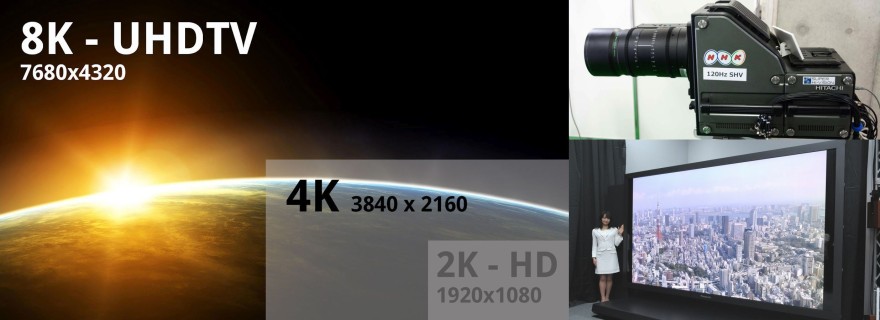Your 1080p HDTV is a piece of crap. So says the consumer electronics industry, which wants very badly to get you to upgrade to higher resolution screens, whether you really need them or not. As many manufacturers begin the push for 4k “UHD” displays, here comes an 8k format right on its heels. Just how many Ks do we really need?
Just recently, a very optimistic study predicted that the adoption rate for 4k TVs will move even swifter than the current 1080p standard did, and should be ubiquitous in 10-12 years. (1080p took about 15 years.) I find that claim a little dubious, personally, but a lot of powerhouse companies are already banking on it.
Meanwhile, Japan’s national broadcaster NHK believes that even 4k is a pile of garbage. The firm has been developing an 8k format called “UHDTV” and promises to broadcast the 2020 Tokyo Olympics at an astounding 7680×4320 resolution.
With any digital product, a game of specsmanship inevitably sets in, as companies compete to provide some specification or measurement with a higher number than its rivals, regardless of whether that number is actually relevant to the end user’s needs. Sometimes, especially if the price difference is not too significant, these numbers alone are enough to sway consumers toward the supposedly better specs. “Your cell phone camera is 4 Megapixels? What a joke, mine is 8 Megapixels!” Never mind that the tiny lens in the camera is incapable resolving more than 3 Megapixels of actual picture information, and that cramming more and smaller pixels onto the digital sensor can actually increase noise in the image and make the results look worse. 8 is a higher number than 4, and therefore must be better!
1080p emerged as our current HDTV standard because it hits a sweet spot in displaying high-frequency detail that the human eye can resolve without visible pixel structure, even on large screen sizes. I’m not saying that 4k is useless for home theater , but the additional detail it provides will likely not be discernable except on the largest of projection screens, and even then only if viewers sit within a fairly close distance to the screen. I’m sure that it won’t be very long before we see 4k TVs of sizes down to 32″ or smaller in stores, and I fail to see the point of that.
As for 8k, I’m skeptical that there will be any practical use for it at all.
I reserve the right to change my mind when these products hit the market at a price I can afford, but at the moment, I’m in no hurry to replace my entire home theater system from top to bottom (disc players or other video sources, cables, video processors, A/V receiver and projectors) to accommodate all these additional Ks.






Chris B
To hell with 8k! Make mine 16k! Seriously though this whole UHD thing seems like a ton of hype. I’ve heard over and over from home theatre expects (including the ones on this very site), that unless you’re buying a 100 inch screen or larger the added pixels won’t even make a discernible difference in image quality. My question is: Why are the big electronics manufacturers forging ahead with the UHD branding when they must have been told the same thing? Are they just banking on the fact that consumers are so ignorant they’ll buy something simply because it has a higher number on it? Geez that’s pretty effing insulting to their customer base and a pretty sad commentary on us if we all swallow the bull without actual proof there will be a substantial improvement in image quality.
Here’s the question I’ve been asking lately, if 4K isn’t the next step in the evoulution of home theatre then what is? What improvements can technology offer us? What’s next?
Josh Zyber
AuthorThat’s a damn good question, Chris. If we’ve already hit the point of diminishing returns on pixel count, what is the next evolution for home theater? Some people thought 3D was the answer, but that hasn’t panned out.
While there are certain improvements I’d surely like to see, such as 21:9 support or expanded color depth natively encoded on the disc (or other video format), I don’t imagine many consumers would really consider those significant enough to merit equipment upgrades.
Bill
We bought HD TVs. And the hardware guys were able to sell lots and lots of brand new equipment (TVs, Blu-ray players, Receivers, and incredibly over-priced HDMI cables…)
They want to return to those hay-day glory days of hardware sales. And they hoped 3D would do. (It didn’t – thank goodness.) Now they think 4K (or 8) will do it? Probably not. Unless that’s why they build TVs so cheaply/badly today? Forcing us to upgrade sooner as the TVs die? Maybe…
My hope for the future – http://www.dolby.com/us/en/professional/technology/home-theater/dolby-vision.html – that’s what I’m willing to pay for in the future. Give me new specs for not only an expanded color space but for brighter pixels as well. I want an actual better picture, not just more pixels using the same limited color space and brightness limits we’ve been using for decades…
(Side-note – I would also like a flat, not curved, OLED TV at a reasonable price. Until that comes out, I’ll keep my years-old plasma, thanks.)
Chris B
Thanks for posting that link! I’d never heard of Dolby Vision before, but it definitely looks promising. Hopefully hardware manufacturers are able to integrate it soon…
William Henley
4k taking off is not an unreasonable dream. People are now starting to get into larger screens. My first HDTV was 32, and I thought it was fine, then I got 42 and for about 5 years, thought I never needed anything bigger. Now I have 65.
You could say that I am just a home theater enthusiast, and that is true, but I am starting to see more and more of my friends buy larger screens (ie 55 inch and larger). The thought process goes “well, the 47 inch is just about $100 more than a 42 inch. Well, if I am spending that much, for an extra $150, I can go 52 inch. Oh, but for an extra $100, I can go 55 inch. But if I am now spending that much, for an extra $100 I can go 60. And for $150 more than that, I can go 65 inch”
Suddenly people are now walking out of stores with 65 and 70 inch televisions. I also have a few friends looking into projectors, and are saying that will be their next upgrade, cause we can go 100 inches or bigger for about the same price as a 60-70 inch television (depending on brand and specs for both the television and projector).
Now, on the display models at the stores, the 4k televisions that are 65 inches is where you can really start seeing the difference. Add the extended color palete, and you really have an awesome WOW factor.
If the content is there, and prices come down, I can see 4k taking off in the next 10 years. There IS a picture difference (even though its minute – hey, when is the last time you saw a television only offering 720p on screens say 32-42 inches), and you don’t have to wear glasses or sit at certain viewing angles to experience the added benefits (although screen size and distance will give you a diminishing return).
I can’t comment on 8k, though. I haven’t seen it.
BTW, I FINALLY got my mom to have a “WOW” experience on Blu-Ray. She has admitted for a while that it does look better, but didn’t think it looked that much better. Than I bought her season 1 of Little House on the Prarie on Blu-Ray. She didn’t understand at first why I sent it to her, as she has the entire series on DVD, but I kept encouraging her to stick it in. She was so impressed, she actually took to Facebook talking about how much better it was, how much the picture popped, how she was noticing things she had never seen before, and was encouraging everyone to check it out. She even provided a link to buy it, which I did not think she even knew how to do that.
So yeah, I can see 4k taking off. 8k, eh, if the price point is right and there is content available, than yeah, maybe. But they will want to make sure its backward compatable with the 4k format, and they need to get it on the market ASAP. If the price point is on par with 4K televisions, and they can get 8k sets in the stores within the next year, thank yeah, I can see 8k taking off, because people will take a look at it and go “Hey, that’s twice as many Ks”.
Josh Zyber
AuthorThe problem with televisions (as opposed to projectors) is that there’s a limit to how practical buying a super-large screen can be. 65 inches is pretty much as large as a TV can go and still fit through most people’s doors. Yet 65 inches is at the bottom end of just starting to be able to discern the difference between 1080p and 4k. Anything smaller than that, and there’s really no point to 4k.
Until flexible OLED screens that you can roll up in a tube are available and affordable, you won’t see many people knocking down walls of their homes to install 100″ televisions. Projectors of course are much more practical for large screen display, but those are still a tiny niche of the consumer market. They’re not driving the push for 4k.
William Henley
True. I bet I probably could have fit upwards of an 80 through my door (I certainly could have fit a 70 in). In fact, the 70 was only $200 more than the $65, but if I had of went with that, the entertainment center wouldn’t have been large enough, and the one that supported larger screens was several hunderd more. So while the screen size would have only set me back an extra $200, the added cost of a larger entertainment center would have set me back about $700 more.
Now 100 inch televisions are certainly impractical, but may be an option for people who rent houses and apartments – assuming they are smart enough to measure the box before trying to swing it up those stairs and into the apartment and down that entry hall.
4k televisions may find their core audience in the 60″-80″ market.
Alan Fidler
“Your 1080p HDTV is a piece of crap”
LOL! Thanks.
Gino
I ‘can’ see the difference between ultra 4k and 1080hd quite clearly when they are both 60 inch tvs beside each other.
The 4k ultra hd really does create a more three dimensional look. I believe that it will take off. 8k will also take off for those who want monster screens five to seven years from now. I wonder what you think of ultra higher def on blu-rays; how do they do it?? Will there be ultra high blur-ay discs?
Thanks Josh